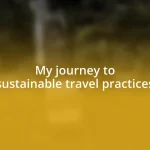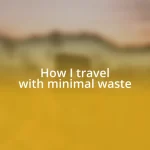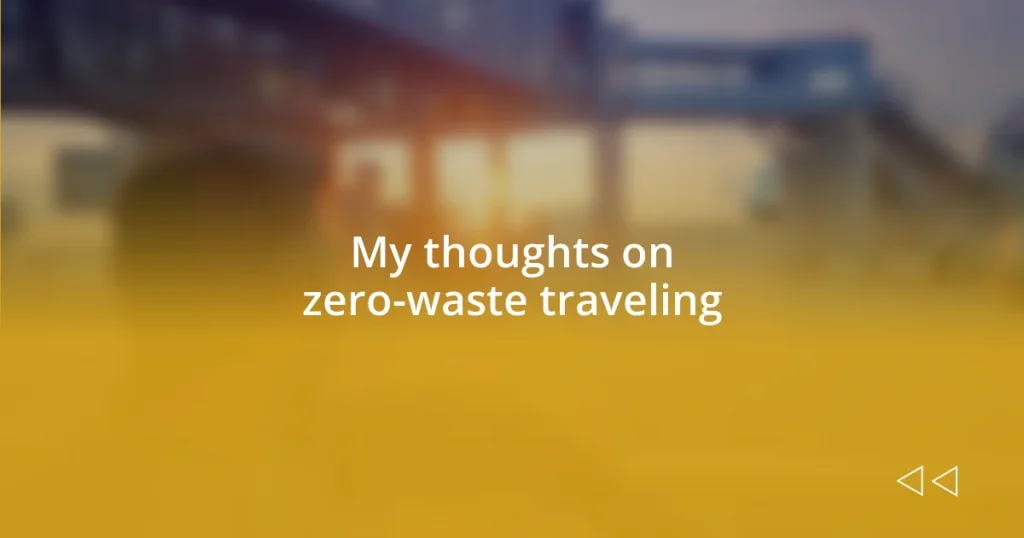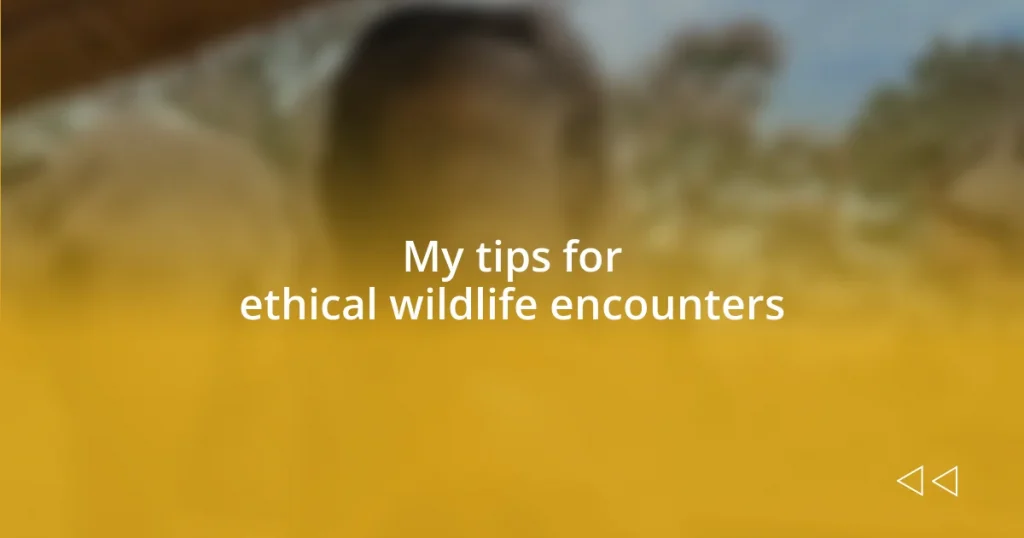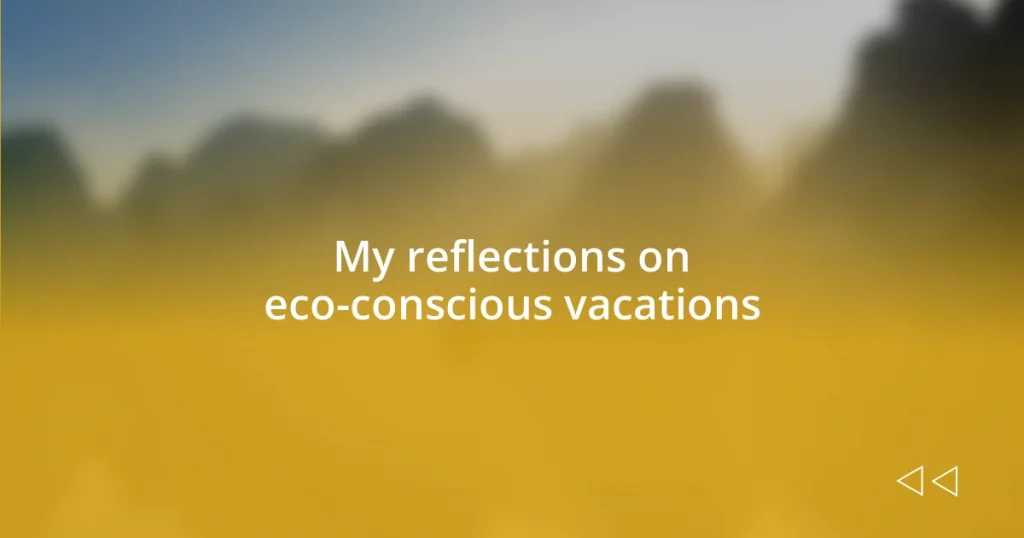Key takeaways:
- Planning your backpacking route should begin with selecting desired countries and prioritizing experiences to create a meaningful itinerary.
- Essential items for backpacking include a durable backpack, packing cubes, a quick-drying travel towel, and a reliable power bank.
- Maintain health and safety by staying hydrated, being aware of surroundings, having vaccinations, and considering travel insurance while respecting local customs and etiquette.

Planning your backpacking route
When planning your backpacking route through Southeast Asia, I often recommend starting with a rough idea of the countries you want to visit. For instance, during my travels, I found myself enchanted by the vibrant streets of Thailand and the serene beaches of Vietnam. Have you ever been captivated by a destination that pulled you in? That’s the kind of inspiration I suggest you lean into when mapping out your journey.
Once you have your countries pinned down, think about the experiences you crave. I remember sitting on a train in Malaysia, gazing out at lush green landscapes, and realizing that some of the most beautiful moments happen unexpectedly. Are you hoping for thrilling adventures, cultural experiences, or a bit of relaxation? Clarifying your priorities can dramatically shape your itinerary and make those connections with the local culture more meaningful.
As you sketch out your route, don’t forget to consider transportation. I learned the hard way that booking last-minute transport can lead to missed connections and unplanned layovers. Do you want to spend your time exploring or stressing over logistics? By planning your travel between major destinations in advance, you can devote more energy to enjoying the journey itself, making each moment worthwhile.

Essential items for backpacking
When it comes to essential items for backpacking, packing wisely can make a world of difference in your travel experience. I’ve always found that a durable backpack is crucial; it’s your lifeline on the road. Alongside it, investing in packing cubes helped me stay organized. Who wants to sift through a jumble of clothes when you can simply pull out a cube?
Another necessity I swear by is a versatile travel towel. When I traveled in Laos, I was amazed at how quickly my microfibre towel dried after a swim in the Mekong River. It’s lightweight, quick-drying, and takes up minimal space. Those little comforts can transform a trip, don’t you think?
Lastly, I can’t stress the importance of a reliable power bank. On my recent adventure in Cambodia, my phone died unexpectedly while I was navigating through bustling markets in Phnom Penh. With a power bank, I would have been able to recharge and keep capturing those beautiful moments on my camera. Trust me; you don’t want to be caught without one of these essentials when adventure calls!
| Essential Item | Description |
|---|---|
| Durable Backpack | Your main luggage, crucial for carrying all essentials comfortably. |
| Packing Cubes | Organizers that help keep your clothes and gear neat and accessible. |
| Travel Towel | Quick-drying, lightweight towel that’s great for beach days or unexpected showers. |
| Power Bank | Portable charger to keep your devices powered on the go. |

Budgeting for Southeast Asia travels
When it comes to budgeting for your travels in Southeast Asia, I can’t stress enough how flexible yet strategic you need to be. My first trip there had me staring at a menu in Vietnam, completely taken aback by how little my meal cost compared to what I’d pay at home. It’s this kind of pleasant surprise that can really help with budgeting because it allows room for spontaneous adventures. You might find yourself in a beautiful café in Chiang Mai, where a delightful cup of coffee can cost just a dollar!
Here’s a quick breakdown to give you a clearer picture of daily expenses:
- Accommodation: $5 – $15 for hostels or budget hotels.
- Food: $1 – $5 for local street food; $7 – $15 at restaurants.
- Transport: $0.50 – $3 for city transport; $10 – $40 for longer bus rides.
- Activities: $1 – $10 for entry fees to temples or parks; $20+ for guided tours.
Always keep an eye on where your money goes and be prepared to adjust periodically. It’s a wonderful feeling to be traveling at a low cost while enjoying rich experiences—the kind of feeling that makes every dollar feel like a cherished investment in memories.

Navigating transportation options
Navigating transportation options in Southeast Asia can feel daunting at times, but I assure you it’s part of the fun. I’ve hopped on crowded local buses in Thailand and found the experience to be surprisingly charming, with friendly locals often offering tips and sharing laughs. It’s refreshing to see how welcomed I felt, even in the chaos of a bustling city.
Then there are the low-cost airlines, like AirAsia, which opened up so many regions for me to explore without breaking the bank. I remember booking a last-minute flight from Bali to Lombok for less than a dinner out—talk about a steal! However, I’ve learned to be cautious about added fees; the low ticket price can quickly inflate when you add luggage.
Don’t forget about trains either! My journey on the overnight train from Hanoi to Sapa was unforgettable. As I nestled into my compartment, I felt an excitement akin to childhood adventures. The gentle rocking of the train lulled me to sleep, while the stunning landscapes outside unfolded like a movie the next morning. It’s these experiences that really make traveling memorable, don’t you think?

Health and safety tips
When it comes to health and safety while backpacking through Southeast Asia, staying hydrated is key. During one particularly sweltering day in Laos, I foolishly overlooked this. By the afternoon, I was feeling dizzy and disoriented. Trust me, it’s essential to drink plenty of water, especially in humid climates. I always opt for bottled water from reputable brands to avoid any nasty surprises, like stomach issues that can put a damper on your travels.
Another important tip is to stay aware of your surroundings. I remember walking through the vibrant streets of Ho Chi Minh City, where the buzz of activity felt almost intoxicating. Yet, amidst the excitement, I kept an eye on my belongings and avoided flashing valuables. Just a little caution can go a long way. If you’re out at night, stick to well-lit areas, and consider traveling with a buddy—there’s safety in numbers.
Don’t forget about vaccinations and travel insurance! Before my first trip, I consulted with a travel clinic to make sure I was up to date on necessary shots. It’s reassuring to know I’m protected against diseases that may be more common in certain areas, like typhoid or hepatitis. Travel insurance felt like a safety net; I remember having peace of mind while diving in Thailand, fully aware that I would be covered for any unforeseen mishaps. So, what’s more valuable than your health and peace of mind while exploring new destinations?

Cultural etiquette while traveling
It’s essential to understand the cultural etiquette of the places you visit, especially in Southeast Asia, where customs vary widely. I vividly remember my first encounter with the Thai concept of “wai.” It’s a respectful greeting that involves a slight bow with hands pressed together. This simple gesture not only helped me connect with locals but also deepened my appreciation for their culture. Experiencing the warmth of a “wai” in return always made me feel honored and welcomed.
In Buddhist countries, modest dressing is crucial, especially when visiting temples. I learned this the hard way when I showed up in shorts to a stunning temple in Cambodia. The disapproving looks from the monks were enough to send me scurrying for a sarong. Now, I always keep a light scarf or wrap in my bag when I’m out exploring. It’s a simple way to show respect and ensure that I don’t unintentionally offend anyone.
Tipping can also be a cultural nuance that caught me off guard. In some places, like Vietnam, it’s not always expected, while in others, like Bali, it can be a way to show appreciation for good service. I recall a delightful evening at a restaurant where the waiter went out of his way to accommodate my dietary needs. Leaving a small tip felt like a heartfelt thank you to him. So ask yourself, how can a little gesture of gratitude enhance your travel experience and foster meaningful connections with the locals?




